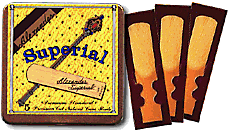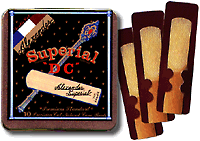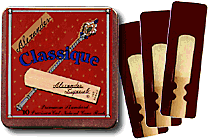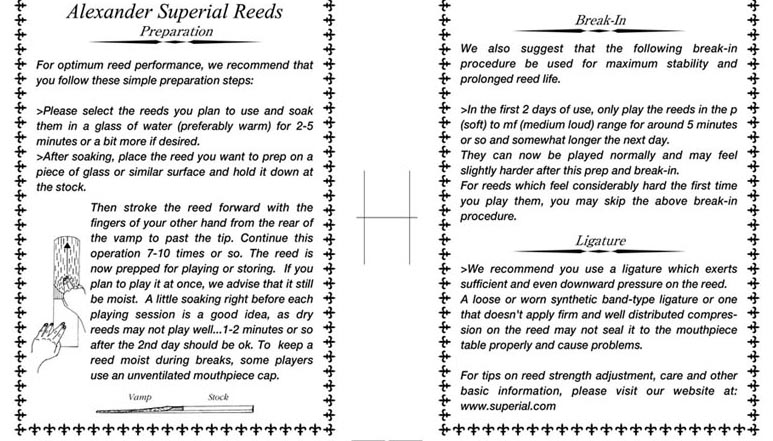| zum Produkt |
| Tom
Alexander entwickelte diese Blätter unter der Mithilfe
zahlreicher Saxophonisten und des Mundstückexperten Ralph Morgan. Das erste Blatt, dass er auf den Markt brachte war das Superial. Ein Blatt konzipiert nach traditioneller Tonvorstellung. Es ist aus dem Trio das hellste und obertonreichste Blatt mit dem geringsten Blaswiderstand. 1995 wurde das Superial DC auf dem Markt eingeführt. Es besitzt einen Querschliff ( DC = double cut ) und ist im Schnitt insgesamt etwas dicker und besitzt etwas mehr Holz in der Spitze, im Herz und an den Seiten. Es klingt etwas dunkler als das Superial , projiziert sehr gut und hat einen geringfügig höheren Blaswiderstand als das Superial-Blatt Die meisten Saxophonisten bevorzugen diesen Schnitt. |
 |
 |
 |
| Superial | Superial
DC |
Superial
Classique |
| Das
Superial Classique kam
1997 auf den Markt. Es hat den dicksten Schnitt (etwas leichter
als Vandoren classic) und richtet sich in
erster Linie an den klassischen Saxophonisten und
Klarinettisten. Aus
unserer Erfahrung bevorzugen aber auch sehr viele Jazz-Saxophonisten
und -Klarinettisten Blätter mit einem solchen, dickeren Schnitt.
Wenn es
gelingt den etwas höheren Blaswiderstand "zu
überwinden" kann man
hiermit einen Ton mit sehr viel Projektion, Lautstärke und Volumen
erzeugen. |
2007 Neuerscheinung Alexander NY -New York |
| Alexander NY - New York After the introduction of Superial, ''DC'', and Classique in the 1990's, we began to conceive of a model which would add a new and different dimension to the tonal universe of our reeds. This reed was born following extensive conversations between Tom Alexander and a legendary Jazz saxophonist friend some years ago, and through experimentation with different prototype designs. It has also been thoroughly field tested by subjecting it to many months of on the job playing in the concert and tour performances of several of our World Artists who've now given it their seal of approval. The result is a new reed made with our same high grade S. France cane, yet a redesigned tip and profile which produces a big and bold sound, full response throughout the registers and the type of vibrant, solid tone traditionally associated with that of the New York music scene. The tip is somewhat harder than DC which gives it a sustaining power, especiially in the high end of the horn. |
|
| Alexander Superial In the early 1990's, after many months of intense development and testing of prototypes, the original "Alexander Superial" was put into production. Our
aim with this first model was to design a reed which produced a warm,
resonant "buzz", good projection, even scale throughout the registers,
and a wide dynamic range. In other words we wanted this reed to provide
a tonal platform that was free blowing, capable of quick and accurate
articulation, and one that gave immediate presence. |
|
| Alexander
Superial DC After introducing Superial, I wanted to add another model to our line which I thought might meet the needs of players who were looking for a different style cut and tonal response. Using the same cane, we made exhaustive tests and alterations to fabricate a reed with somewhat changed response characteristics from the original Superial, and thus the new Superial ''DC'' (or ''Double Cut) was created. This reed has a slightly harder tip and more wood in the heart and sides than Superial and therefore produces a more solid tonal core, enhanced projection and power, and a little darker harmonic timbre than Superial, but still one with the kind of ''edge'' and authority needed in soloing or lead work. For ''DC'' I was thinking in terms of a tonal concept reminiscent of the saxophonists I had admired and been influenced by from the 1950's to the ''Blue Note'', ''Miles'' and ''Trane'', and ''Wayne'' eras. I also had in mind a reed of increased power that would be particularly suitable for big band, stage band or marching reed players, as well. So in a sense, I worked on ''DC'' with an idea of making a reed that fit closest to the tonal palate of my own musical influences and this became the reed I used on Tenor most of the time. Since its introduction in 1995, ''DC'' seems to be especially favored by professionals who need a lot of power and want to push the reed to the limits of its dynamic capabilities, while still retaining an even balance from top to bottom. |
|
| Alexander
Classique In 1997, following the introduction of Superial and ''DC'', we felt another line of reeds was needed to address the specific needs of classical woodwind players or jazz players wanting a bit more resistance and darkness in their set up than our other models offer. Starting with the clarinet model, we tried to conceptualize what kind of reed we could create that would provide musicians with a wide palette of expression, and classically grounded performance characteristics...those that produce a warm, dynamically balanced, sonorously beautiful tone. While investigating what direction of design we should pursue, we knew that there had been a reed made years ago which classical clarinetists spoke of in almost reverential tones. Although this reed never became as commercially successful as some of the more ''name'' brands, it had been in fact used by some of the top clarinetists in the world, among them some members of the Chicago Symphony clarinet section. To the lament of many, production ceased some years back. We worked on a prototype which was influenced by this reed's design, but with certain improvements that we felt would actually make it more suitable to present day musical settings. This same philosophy was also followed for the saxophone models but with a somewhat different profile design we felt would bring out the best in that instrument. We also had the advantage of using more accurate hardness testing and cutting machines so we could manufacture a much more consistent reed than the original model. With testing feedback from some top professional classical clarinetists and saxophonists, we arrived at the final design of this new reed line christened ''Classique''. We went into production for all models and Classique is now being used not only by classical and concert performers, but any others looking for a darker tone which this reed's harder tip and heart produce. In Classique, we believe we have achieved our goal of capturing the essence of that great traditional design, but with improvements developed to enhance dynamic response, clarity and register balance, which we feel produces a ''singing'' tonal quality that is definitely classical in its conception. It should also be noted that a growing number of jazz players seem to enjoy Classique's response these days as well. |
